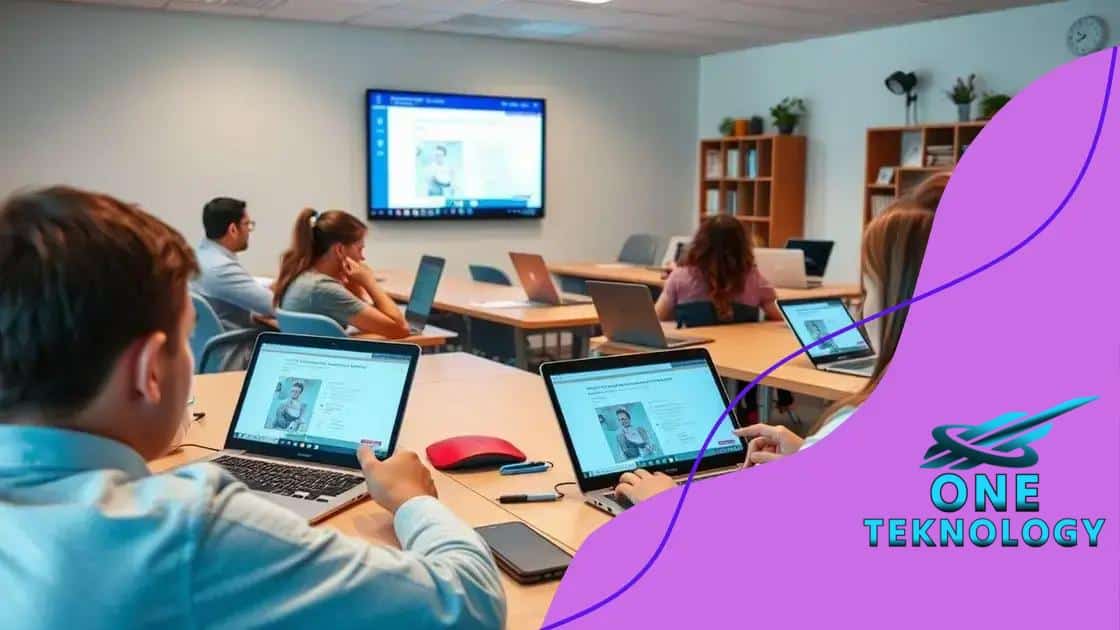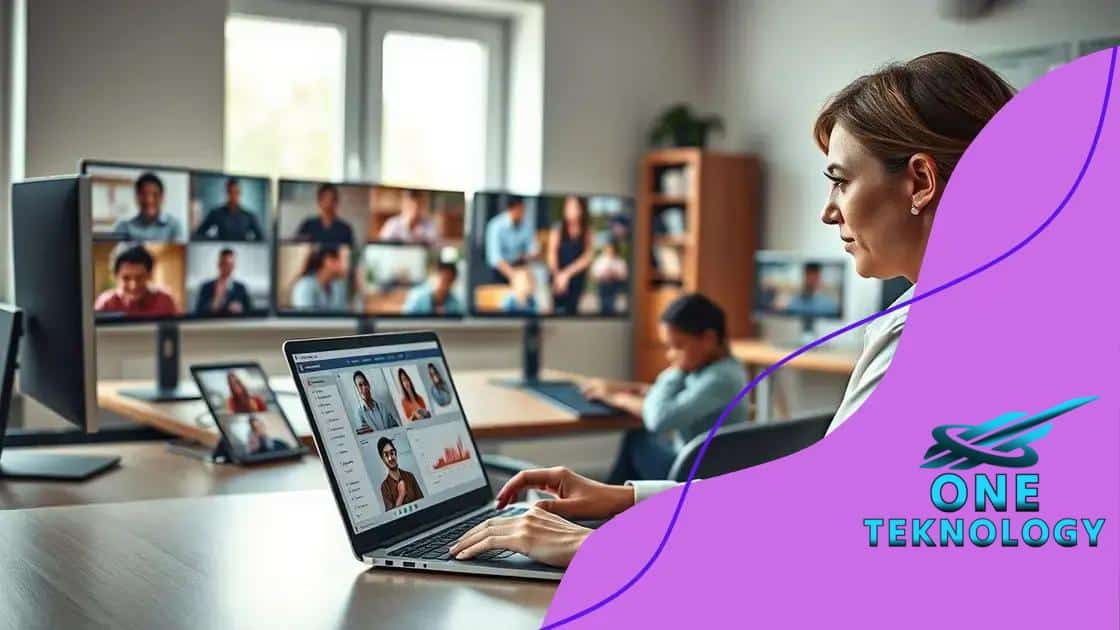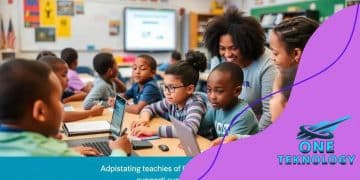Digital tools for enhancing remote learning experiences

Digital tools for enhancing remote learning experiences significantly improve student engagement, collaboration, and accessibility, making education more effective and tailored to individual needs.
Digital tools for enhancing remote learning experiences have become essential in today’s educational landscape. They not only facilitate learning but can also inspire students to engage more deeply. Have you considered how these tools shape your learning journey?
Benefits of digital tools in education
Using digital tools in education brings numerous advantages that can significantly enhance the learning experience. These tools can make lessons more interactive and accessible for students of all ages. One major benefit is improved engagement, as digital tools often allow for dynamic content that captures students’ attention.
Increased Accessibility
Digital tools can also increase accessibility for students with diverse learning needs. For example, applications that provide text-to-speech or speech-to-text functionalities can help students who struggle with traditional reading or writing methods. This means that everyone has a better chance to participate fully in class activities.
Enhanced Collaboration
Collaboration is another key benefit of using these tools. Students can easily share their work and ideas through platforms such as Google Docs or Microsoft Teams. This not only fosters teamwork but also allows for peer feedback, which can be invaluable.
- Real-time collaboration on projects.
- Customizable learning experiences.
- Easier access to resources and information.
- Opportunities for connecting with experts and mentors.
Another exciting aspect of digital tools in education is the ability to analyze learning data. Teachers can monitor student progress through various analytics dashboards, making it easier to identify areas where students may need additional support. This data-driven approach can lead to more personalized instruction, ultimately improving learning outcomes.
Furthermore, the use of digital tools can promote independent learning. Students can explore subjects at their own pace, utilizing online resources and interactive content that encourages curiosity. This freedom can inspire a love for learning that extends beyond the classroom.
Cost-Effective Solutions
Finally, many digital tools are cost-effective alternatives to traditional resources. Learning management systems and educational apps often come with free versions, making them accessible to schools with limited budgets. This democratization of education resources is crucial for reaching underserved communities.
Interactive platforms for student engagement
Interactive platforms play a crucial role in student engagement, especially in remote learning environments. They encourage students to participate actively in their education, making learning both fun and effective. Utilizing interactive platforms can lead to increased motivation and deeper understanding of the subject matter.
Types of Interactive Platforms
There are several types of interactive platforms that educators can use to enhance learning. These include learning management systems (LMS), educational games, and virtual classrooms. Each of these platforms allows students to interact with the content in meaningful ways. For example, an LMS like Canvas or Moodle enables teachers to create engaging assignments and quizzes that provide immediate feedback.
- Learning management systems for structured course delivery.
- Educational games that make learning enjoyable.
- Virtual classrooms that facilitate real-time interactions.
- Collaborative tools for group projects and discussions.
Furthermore, many interactive platforms allow students to learn at their own pace. This means that learners who may struggle with traditional classroom settings can take their time to understand the material fully. Additionally, teachers can customize lessons based on individual needs, which adds flexibility to the learning process.
Engagement Through Gamification
One popular trend in student engagement is gamification, where elements of games are integrated into the learning experience. By earning points or rewards, students feel more motivated to complete tasks. This approach can make subjects that are often seen as difficult more approachable and enjoyable.
Interactive quizzes and polls also serve to engage students actively. For instance, using platforms like Kahoot or Quizizz allows teachers to create fun quizzes that students can answer in real time, fostering healthy competition and collaboration among peers. The use of instant feedback helps to reinforce learning and address misconceptions promptly.
Tools for organizing remote classes

Organizing remote classes effectively can be challenging, but the right tools can make a significant difference. By leveraging various tools for organizing remote classes, educators can streamline communication, enhance collaboration, and improve the overall educational experience for students.
Essential Tools for Class Management
Several essential tools help in managing online classrooms. Learning Management Systems (LMS) like Google Classroom, Canvas, and Blackboard provide a centralized platform for teachers to distribute materials, assign tasks, and track student progress.
- Google Classroom for easy assignment distribution.
- Canvas for comprehensive course management.
- Blackboard for a robust learning environment.
- Moodle for customizable learning experiences.
These platforms not only organize coursework but also foster communication between students and teachers. Students can ask questions and engage in discussions, making learning more interactive.
Scheduling and Collaboration Tools
In addition to LMS, scheduling and collaboration tools are crucial for remote teaching. Applications such as Zoom and Microsoft Teams allow for real-time conferencing, enabling teachers to conduct live classes and interact with students directly.
Moreover, using tools like Trello or Asana can help organize class projects and group assignments. With these platforms, students can manage tasks collaboratively, making it easier to keep track of progress and deadlines.
When students know what to expect, they feel more confident in their learning environment. Utilizing shared calendars can also help keep everyone on the same page regarding important dates and deadlines. This level of organization leads to a more productive learning atmosphere.
Assessment and Feedback Tools
Assessment tools are vital for measuring student understanding. Platforms like Quizlet and Kahoot allow teachers to create quizzes and interactive assessments that provide instant feedback. Such tools can increase student engagement and provide insights into learning progress.
Additionally, incorporating feedback tools like Google Forms allows students to share their thoughts about classes, which can help teachers refine their teaching strategies. This feedback loop not only improves the learning process but also enhances student satisfaction.
Enhancing collaboration among students
Enhancing collaboration among students is essential for a successful learning experience. Using various digital tools, educators can foster teamwork and communication, making remote learning more interactive and effective. When students collaborate, they can share ideas, challenge each other, and develop critical thinking skills.
Collaboration Tools
Several online tools facilitate collaboration among students. Platforms like Google Workspace, Microsoft Teams, and Slack allow students to communicate effectively and work together on projects.
- Google Workspace provides shared documents for real-time editing.
- Microsoft Teams integrates messaging and video calls for seamless interaction.
- Slack offers organized channels for group discussions.
- Trello helps students manage tasks and project timelines.
These tools create a virtual environment where students can engage with their peers easily. They can ask questions, provide feedback, and brainstorm ideas together, which enriches their learning experience.
Encouraging Group Projects
Group projects are another excellent way to enhance collaboration. By working together, students can draw from each other’s strengths and divide tasks based on individual skills. This teaches important lessons about teamwork and accountability.
Using tools like Padlet or Miro, students can visualize their ideas and gather feedback from their peers. These platforms allow for interactive brainstorming sessions that make collaboration exciting. Additionally, educators can set clear roles within groups to ensure everyone participates.
Moreover, considering online forums or discussion boards can promote collaboration outside of scheduled class times. Students can engage in meaningful discussions about their assignments or share resources, maintaining momentum and fostering a sense of community among peers.
Benefits of Collaboration
Ultimately, enhancing student collaboration leads to numerous benefits. When students work together, they often achieve better academic outcomes. They learn to communicate more effectively, empathize with others, and respect diverse viewpoints. These skills are not only valuable in the classroom but also prepare students for future careers.
Engaging in collaborative tasks helps students become more confident in sharing their ideas, reducing anxiety around participation. In a supportive and interactive environment, learners are more likely to feel motivated to participate and contribute meaningfully.
Evaluating digital tools for effectiveness
Evaluating digital tools for effectiveness is crucial for ensuring that students receive the best possible learning experience. With numerous tools available, it’s important to assess their impact on student engagement and academic success. A systematic approach can help educators identify which tools best meet their needs.
Criteria for Evaluation
When evaluating digital tools, several criteria should be considered. These include usability, engagement, accessibility, and the ability to fit within the curriculum.
- Usability: The tool should be easy to use for both teachers and students.
- Engagement: It should promote active participation and keep students interested.
- Accessibility: The tool must be accessible to all students, including those with disabilities.
- Curriculum Alignment: The tool should align with curriculum goals and learning standards.
By using these criteria, educators can make informed decisions about which tools to implement in their classrooms.
Data-Driven Decision Making
Data is a powerful tool that can help educators evaluate the effectiveness of digital tools. By analyzing performance data, such as student grades, engagement metrics, and feedback surveys, teachers can gain insights into how well a tool is working.
For instance, if students are consistently performing better after using a particular tool, it likely indicates its positive impact. Conversely, if engagement levels drop or feedback is negative, it may be time to reconsider its use. Using analytics dashboards allows teachers to track student progress and adapt their teaching strategies accordingly, leading to more personalized instruction.
Continuous Improvement
Evaluating digital tools should not be a one-time task. A continuous improvement mindset is essential for maintaining effectiveness. Regularly revisiting the evaluation process allows educators to stay updated on new features or alternatives that may better serve their students.
Additionally, collaborating with other educators to share insights and experiences with various tools can enhance understanding and provide valuable feedback. This network can help teachers discover innovative ways to incorporate technology into their lessons, fostering increased engagement and learning outcomes.
FAQ – Frequently Asked Questions about Digital Tools for Enhancing Remote Learning Experiences
What are some key benefits of using digital tools in remote learning?
Digital tools in remote learning enhance engagement, facilitate collaboration, and make education more accessible for all students.
How can teachers evaluate the effectiveness of digital tools?
Teachers can assess effectiveness by analyzing performance data, student feedback, and engagement metrics to see how well tools support learning.
What platforms can help organize remote classes?
Platforms like Google Classroom, Microsoft Teams, and Zoom can help organize remote classes by offering assignment distribution, communication, and live interactions.
How does collaboration among students improve learning?
Collaboration encourages students to share ideas, work together, and develop important skills such as communication and critical thinking.






